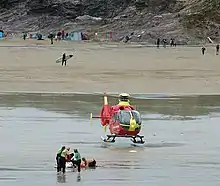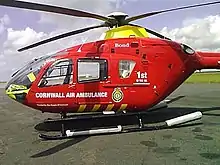Cornwall Air Ambulance
The Cornwall Air Ambulance Trust is a charity that provides a dedicated helicopter emergency service for Cornwall and the Isles of Scilly.[2] The helicopter flies about 1,100 missions per year and, as of December 2018, had flown over 28,000 missions.[3]
_cropped.jpg.webp) | |
| Founded | April 1987 |
|---|---|
| Type | Charitable organisation |
| Location |
|
| Coordinates | 50.4329°N 4.9838°W |
Area served | Cornwall and the Isles of Scilly |
Chief Operating Officer | Steve Murdoch |
Aircraft operated | Leonardo AW169 |
Revenue (2019) | £7.7 million[1] |
Staff (2019) | 41[1] |
Volunteers (2019) | 266 |
| Website | cornwallairambulancetrust |
When introduced on 1 April 1987, Cornwall's air ambulance was the first dedicated helicopter emergency medical service (HEMS) operational in the United Kingdom.[4] The helicopter primarily provides HEMS through the delivery of a critical care team for the county. It enables a fast response to the most critically ill or injured and can facilitate access to isolated locations, such as beaches, cliff-tops and moorland areas, which are inaccessible by road.
Operations

The helicopter is based at a hangar at Newquay Airport (EGHQ),[5] near Newquay, which enables servicing and maintenance to be carried out overnight, which was impossible at the original open-air base at Royal Cornwall Hospital in Treliske. The new base is also more centrally located, leading to quicker response times in many parts of the county. The helicopter can be airborne within two minutes of an emergency call and flies at 145 knots (165 mph / 270 km/h).[6] It can cover the entire county in less than 20 minutes and reach the Isles of Scilly in 28 minutes. On average it takes 12 minutes from the time of the call to the scene of the incident.[5]
The southern clinical hub for South Western Ambulance Service (SWASFT), located at Exeter, makes decisions regarding air ambulance mobilisation across the SWASFT coverage area.
Aircrew
The air ambulance carries a crew of three: one pilot plus either two critical care paramedics, or a critical care paramedic and a doctor. Paramedics are selected from the ambulance service and specially trained for their work on the helicopter. The training period is a minimum of one year which includes critical care practice and a postgraduate certificate as part of the MSc in pre-hospital critical care/retrieval and transport. Successful trainees are then confirmed in role as specialist paramedics in critical care (SPCC) but are more commonly referred to as critical care paramedics (CCP). They are additionally trained as helicopter technical crewmembers, responsible for air to ground communications as well as navigation and assisting the pilot in flight as required. There was originally a pool of twenty aircrew who worked on the air ambulance on a rotation basis. When they were not on helicopter duty, the crew would revert to their normal jobs on the road ambulances in the county. In 2006, the system was changed: now there are just seven full-time aircrew paramedics to improve continuity, and a team of five doctors, who fly with the paramedics four days per week.[7]
Aircraft
Messerschmitt Bölkow-Blohm Bo 105

The first helicopter was a MBB Bo 105D (registration G-AZTI) which was replaced by a slightly larger Bo 105 (registration G-CDBS) which was used until 2001, when it was replaced with the more advanced Eurocopter EC135T (G-KRNW).
Eurocopter EC135

The EC135 is used extensively as an air ambulance in many places around the world. It has four rotor blades to ensure a smooth flight, which proved particularly beneficial for patients suffering head or spinal injuries. Twin turbine engines give it a cruising speed of 160 mph (260 km/h), and skid landing gear allows it to cope with all types of terrain. Its compact dimensions allow it to land in confined spaces, yet it had room to carry two stretcher patients. It contained all equipment found on any front-line ambulance plus other special items.
MD Helicopters MD902

In late 2014, the aircraft provider changed from Bond Helicopters to Specialist Aviation Services (SAS), who owned, operated and maintained the helicopters. With the change came a change in helicopter and the service then operated the MD Helicopters MD902, with its NOTAR design. As part of the contract the service then had two helicopters (registration G-CNWL and G-CIOS: one on operational readiness, the other on immediate standby in case of engineering requirements or non-availability of the primary aircraft. Both MD902 helicopters were delivered as night capable for HEMS operations in darkness. In 2015, the helicopter was available for 12 hours of the day, a first for the air ambulance service in Cornwall. This meant that during winter months the helicopters were available even during darker hours, thanks to the use of special night vision goggles mounted on the pilots’ helmets.
Leonardo AW169
As of 1 April 2020, Cornwall Air Ambulance now operates a single Leonardo AW169 helicopter (G-CRWL),[8] replacing both of the MD902 Explorer aircraft.[9] The AW169 is owned by the charity, and operated/maintained by SAS. Reasons behind the new aircraft include no requirement to refuel between missions, a greater cruising speed and being able to carry more medical supplies.[10]
Cost and financing
In the year ending 31 December 2019, the charity's income was £7.7 million and expenditure was £4.7M, of which £3.1M was charitable spending on the air ambulance service.[1][11] Operational costs included pilots, service engineers, and insurances; as well as per-hour flying costs including fuel, spares, and servicing. The cost of the critical care paramedics is shared with their employer SWASFT.
Cornwall Air Ambulance is a charitable organisation solely maintained by donations as it usually receives no form of official funding, although in its last financial year it received three government grants totalling £1.4M.[1] Members of the public finance the air ambulance by donations, various fund-raising events, purchase of weekly lottery tickets and legacies.
References
- "Charity Overview: Cornwall Air Ambulance Trust". Charity Commission for England and Wales. Retrieved 22 December 2020.
- Scilly Today Busy week for Cornwall Air Ambulance
- "Annual Report 2018" (PDF). Cornwall Air Ambulance Trust. Retrieved 25 June 2020.
- "National Air Ambulance Week". Essex & Herts Air Ambulance Trust. 12 September 2017. Retrieved 29 September 2019.
- "Cornwall Air Ambulance". Helimed181.co.uk. Retrieved 10 February 2012.
- "AW169". www.leonardocompany.com. Retrieved 6 May 2020.
- "Missions - Cornwall Air Ambulance". Cornwall Air Ambulance.
- "Aircraft Data G-CRWL, 2019 Leonardo AW-169 C/N 69100". www.airport-data.com. Retrieved 6 May 2020.
- "New helicopter takes off on first mission". Cornwall Air Ambulance. 31 March 2020. Retrieved 6 May 2020.
- Caygill, Greg. "Cornwall Air Ambulance expects new AW169 will save time & lives". Vertical Magazine. Retrieved 6 May 2020.
- "Charity overview: 1133295 - CORNWALL AIR AMBULANCE TRUST". Charity Commission for England and Wales. Retrieved 25 June 2020.
External links
| Wikimedia Commons has media related to Cornwall Air Ambulance. |